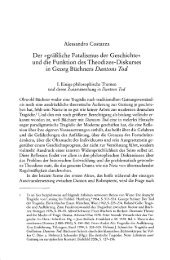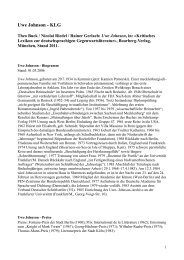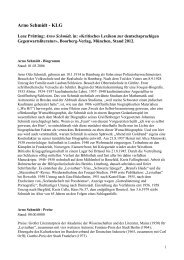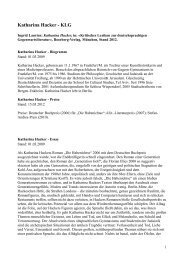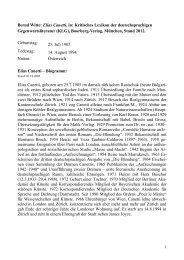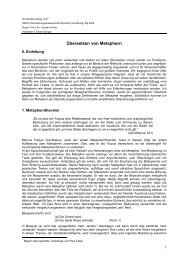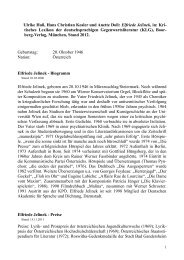Current Opinion in Investigational Drugs
Current Opinion in Investigational Drugs
Current Opinion in Investigational Drugs
You also want an ePaper? Increase the reach of your titles
YUMPU automatically turns print PDFs into web optimized ePapers that Google loves.
40 <strong>Current</strong> <strong>Op<strong>in</strong>ion</strong> <strong>in</strong> <strong>Investigational</strong> <strong>Drugs</strong> 2006 Vol 7 No 1<br />
5-HT1A receptor activation: New molecular and neuroadaptive mechanisms<br />
of pa<strong>in</strong> relief<br />
Francis C Colpaert<br />
Address<br />
Institut de Recherche Pierre Fabre<br />
3 rue des Satellites<br />
BP 94244<br />
31432 Toulouse Cedex 4<br />
France<br />
Email: francis.colpaert@pierre-fabre.com<br />
<strong>Current</strong> <strong>Op<strong>in</strong>ion</strong> <strong>in</strong> <strong>Investigational</strong> <strong>Drugs</strong> 2006 7(1):40-47<br />
© The Thomson Corporation ISSN 1472-4472<br />
Guided by an understand<strong>in</strong>g of signal transduction <strong>in</strong> pa<strong>in</strong>process<strong>in</strong>g<br />
systems, high-efficacy 5-hydroxytryptam<strong>in</strong>e (5-<br />
HT)1A receptor activation, by means of F-13640, has been<br />
discovered as a new molecular mechanism of pa<strong>in</strong> relief <strong>in</strong><br />
laboratory animals, <strong>in</strong>duc<strong>in</strong>g two neuroadaptive phenomena.<br />
Firstly, this activation cooperates with nociceptive stimulation,<br />
paradoxically caus<strong>in</strong>g analgesia, and secondly, <strong>in</strong>verse<br />
tolerance develops so that the result<strong>in</strong>g analgesia grows rather<br />
than decays. As an apparent result of these novel<br />
neuroadaptive mechanisms, F-13640 exerts an analgesic action<br />
<strong>in</strong> rat models of acute, tonic and chronic nociceptive pa<strong>in</strong> that<br />
is rivaled only by large doses of high-efficacy µ-opioid receptor<br />
agonists. In models of neuropathic allodynia of peripheral or<br />
central orig<strong>in</strong>, chronic F-13640 adm<strong>in</strong>istration causes an<br />
analgesia that surpasses that observed with morph<strong>in</strong>e or other<br />
agents exemplify<strong>in</strong>g other central nervous system drug<br />
mechanisms of pa<strong>in</strong> relief (eg, ketam<strong>in</strong>e, imipram<strong>in</strong>e and<br />
gabapent<strong>in</strong>). Indeed, F-13640 produces long-last<strong>in</strong>g, preemptive<br />
and, most remarkably, curative-like actions <strong>in</strong><br />
neuropathic allodynia. Although await<strong>in</strong>g proof-of-concept<br />
evidence <strong>in</strong> humans, high-efficacy 5-HT1A receptor activation<br />
may uniquely challenge the opioids for pa<strong>in</strong> therapy.<br />
Keywords 5-HT1A receptors, analgesia, neuropathic pa<strong>in</strong>,<br />
nociceptive pa<strong>in</strong>, opioids, tolerance<br />
Introduction<br />
Neuroanatomical and physiological studies have long<br />
implicated seroton<strong>in</strong> (5-hydroxytryptam<strong>in</strong>e; 5-HT) <strong>in</strong> the<br />
central nervous system (CNS) control of pa<strong>in</strong> (eg, descend<strong>in</strong>g<br />
<strong>in</strong>hibition) [1], and while a host of 5-HT receptors are known to<br />
mediate the cellular actions of seroton<strong>in</strong> [2], the 5-HT1A<br />
seroton<strong>in</strong> receptor subtype has not traditionally been<br />
considered as a molecular target for pa<strong>in</strong> therapy [3-8].<br />
However, it will be argued here that high-efficacy activation of<br />
CNS 5-HT1A receptors may perhaps now beg<strong>in</strong> to challenge the<br />
opioids as an option for the treatment of pa<strong>in</strong>, although the<br />
latter have been the ma<strong>in</strong>stay treatment of pa<strong>in</strong> for over<br />
thousands of years. Somewhat ironically, this stark<br />
development results from studies <strong>in</strong>to opioid tolerance <strong>in</strong> the<br />
1970s, and from a well-accepted concept that attempted to<br />
account for tolerance to opioid analgesia.<br />
Signal transduction <strong>in</strong> pa<strong>in</strong>-process<strong>in</strong>g systems<br />
The concept account<strong>in</strong>g for opioid analgesia tolerance specifies<br />
that any <strong>in</strong>put to pa<strong>in</strong>-process<strong>in</strong>g systems causes not a s<strong>in</strong>gle<br />
effect, but dual effects that are bidirectional, or opposite, <strong>in</strong> sign<br />
[9,10•,11,12]. Thus, morph<strong>in</strong>e causes not only analgesia as a<br />
'first-order' effect, but also a 'second-order' hyperalgesia that<br />
outlasts opioid receptor activation for some time. The first-order<br />
analgesia results directly from receptor activation, but the<br />
second-order effect is an <strong>in</strong>direct consequence of this analgesia<br />
and follows <strong>in</strong> time. Upon chronic opioid exposure, the secondorder<br />
pa<strong>in</strong>, or sensitization to nociceptive <strong>in</strong>put, grows and<br />
counteracts the first-order analgesia. Thus, opioid tolerance is<br />
due, paradoxically, to opioid pa<strong>in</strong> [10•,13,14].<br />
Intrigu<strong>in</strong>gly, the concept of high-efficacy activation of 5-HT1A<br />
receptors as an option for the treatment of pa<strong>in</strong> suggested that a<br />
mechanism wholly different from opioid receptor activation<br />
could possibly exist, whereby analgesia could be produced.<br />
Indeed, accord<strong>in</strong>g to this concept, the stimulation of peripheral<br />
nociceptors would <strong>in</strong>itially produce pa<strong>in</strong> as a first-order effect,<br />
but also hypoalgesia as a second-order effect; with chronicity,<br />
this second-order hypoalgesia should grow, counteract the firstorder<br />
pa<strong>in</strong> and, remarkably, develop <strong>in</strong>to an <strong>in</strong>creas<strong>in</strong>gly<br />
powerful analgesia (ie, <strong>in</strong>verse tolerance). Of equal importance,<br />
accord<strong>in</strong>g to the concept, is that one nociceptive stimulation<br />
should cooperate with another, concomitant stimulation of<br />
nociceptors to paradoxically <strong>in</strong>duce second-order hypoalgesia<br />
[4,9]. The potential of such an <strong>in</strong>tervention is considerable; it<br />
would be most effective <strong>in</strong> the treatment of severe pa<strong>in</strong> and<br />
would resolve <strong>in</strong>accessible, opioid-resistant, chronic pa<strong>in</strong>s.<br />
Thus, s<strong>in</strong>ce the 1970s, researchers currently at Pierre Fabre SA<br />
have employed an <strong>in</strong>creas<strong>in</strong>g array of neuropharmacological<br />
tools <strong>in</strong> an attempt to identify a mammalian prote<strong>in</strong> and a<br />
molecular action by which the central effects of peripheral<br />
nociceptive stimulation can be mimicked. This prote<strong>in</strong> should<br />
<strong>in</strong>itiate the neuroadaptive mechanisms of <strong>in</strong>verse tolerance and<br />
nociceptor cooperation, and its effects should constitute the<br />
opposite of those of opioids. 5-HT1A receptor activation has<br />
now been identified as the neuropharmacological <strong>in</strong>tervention<br />
whereby those neuroadaptive and therapeutic objectives can<br />
possibly be achieved [15•].<br />
F-13640<br />
F-13640 (Pierre Fabre SA; Figure 1) is a newly synthesized<br />
methylam<strong>in</strong>o-pyrid<strong>in</strong>e that has nanomolar and selective aff<strong>in</strong>ity<br />
for both rat and human G-prote<strong>in</strong>-coupled 5-HT1A receptors; at<br />
1000-fold higher concentrations the compound does not <strong>in</strong>teract<br />
with many other neurotransmitter receptors, uptake sites, ion<br />
channels and enzymes. Importantly, F-13640 has strong activity<br />
at 5-HT1A receptors and stimulates [ 35S]GTPγS b<strong>in</strong>d<strong>in</strong>g by a<br />
magnitude far greater than that observed with the 5-HT1A<br />
agonists buspirone and 8-hydroxy-2-di-n-propylam<strong>in</strong>o-tetral<strong>in</strong><br />
(8-OH-DPAT), and more recently identified selective 5-HT1A<br />
agonists [15•,16,17]. This comb<strong>in</strong>ation of potency, selectivity<br />
and high efficacy can also be observed <strong>in</strong> vivo; after<br />
<strong>in</strong>traperitoneal <strong>in</strong>jection <strong>in</strong> rat, F-13640 readily penetrates the<br />
bra<strong>in</strong> [18], <strong>in</strong>hibits sp<strong>in</strong>al-cord-wide dynamic neuron and<br />
s<strong>in</strong>gle motor unit responses to nociceptive electrical<br />
stimulation [19], and exerts analgesia from (ED50) doses of<br />
0.029 mg/kg upwards [20•]. Its effects are consistently




